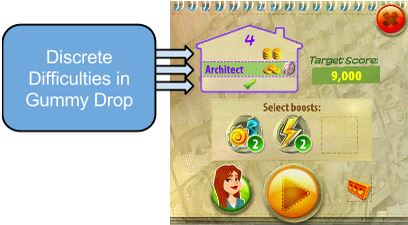
Featured Blog | This community-written post highlights the best of what the game industry has to offer. Read more like it on the Game Developer Blogs or learn how to Submit Your Own Blog Post
Gummy Drop: Rethinking the Saga Map
An analysis of Gummy Drop's refreshing take on a Saga Map and the features that afforded it.

A few months back Gummy Drop, a match three game published by Big Fish Games, was released on the Apple Store and has been doing very well. Although the core mechanic itself isn’t very unique (mostly matching three icons on a grid to achieve specific goals) their variant on how to approach a map makes the game worthy of closer attention. Before diving into their map, I’ll touch on the core change that supported their deviation on the map.
Breaking Out Individual Levels
Often in many match three games players will find a traditional “Three Star System” used to rate the player’s performance, where one star signified passing a level and three stars reflects a phenomenal round. Gummy Drop uses a similar but functionally very different system.
Instead, every level has three discrete difficulties - Apprentice, Architect and Master Builder (think easy, medium, and hard). In order to make any forward progress on the map, players must complete the level at the Apprentice difficulty. At this point, they have the opportunity to replay it at a higher difficulty. Players can continue to replay a level at higher difficulties until they beat it at the “Master Builder” difficulty to finally “complete” the level.
By separating difficulties within a single level, Gummy Drop gains one big affordance - discrete difficulties may yield discrete rewards. Here’s an example of how this often looks within the game:
Apprentice - Small Hard Currency Reward
Architect - Moderate Hard Currency Reward
Master Builder - Large Hard Currency Reward
In general, Gummy Drop’s rewards follow a fairly expected result with higher difficulties equating to larger rewards, but the fact that the designers can adjust the rewards of specific tier within a level is quite powerful.
Before moving forward, it’s important to note that unlike the system above, a traditional “Three Star System” does not easily lend itself to discrete rewards for the player’s performance. For example, imagine we tried mimicking the Gummy Drop’s reward structure within a “Three Star System” like so:
One Star - Small Hard Currency Reward
Two Star - Moderate Hard Currency Reward
Three Star - Large Hard Currency Reward
Now, in the case where a player gains One Star from a level the set-up works nicely. A player can complete the level and easily see that their performance and rewards are linked. But what about the case when a player earns Two Stars? Do they earn both the Small and Moderate Reward? Does the game separate these rewards to show what was earned for each star? Or are the rewards mixed as to not over complicate the screen at the risk of sacrificing the player’s understanding of the underlying reward structure? And this doesn’t even cover the additional cases where a player gains Three Stars on their first attempt at the level.
While I certainly believe that a development team could solve many of these questions posed above, it would take a lot of effort land on a solution that works for developers and players alike.
A Brand New Map
Keeping our discrete rewards in mind, Gummy Drop takes the most advantage of this in their re-imagined map. Specifically, they use this space to borrow successful features from the city simulation genre; one which we've seen time and time again, topping off Highest Grossing charts.
One feature work something like this:
A player completes a level and comes across an unfinished building.
In order to restore it, the player must collect 10 tokens.
Players complete specific difficulty tiers to collect these tokens.
Upon collecting all tokens, the building is restored and the player is given a reward.
I’ve highlighted this mechanic more explicitly below. For a quick reference, each column is a level and each row is that level’s difficulty based on the player’s progress. Since each difficulty tier is able to yield its own rewards, the player may need to complete a level multiple times collecting a building’s token. Even in this simple example, you can see how ten levels of content requires many more completions than you’d normally expect in a traditional saga game.
Squares in blue signify difficulty tiers the player must complete before getting to a token.
So what’s in it for the player?
This particular replay structure clearly has a number of large wins for the developer. But the one that stands out most to me is that developers get considerably more mileage out of individual levels, which in turn increases the available number of core hard currency sinks. Note: By this I mean hard currency sinks that are tied to things like moves, hearts, and boosts.
But what about the player? Sure, the in-game presentation of this content is presented with amazing production value, but what specifically benefits the person sitting down for a quick session of Gummy Drop?
The map functionally matters. It’s kind of a simple takeaway, but take a look at the map in games with similar mechanics and you’ll see that this is significant to note. The map no longer becomes a simple marker of linear progress, but rather opens up the ability to alter the game’s pace, encouraging the player to explore something outside of the game’s core mechanic. Maybe that means completing old levels to restore the last building they found or grinding out hard currency from first few levels to get a use a boost in the level they’re blocked on. Regardless how players use it, the option for this kind of exploration is quite powerful in engaging the players.
Conclusion
Diving into Gummy Drop a few weeks back, I have to say I was originally a bit uninspired. There wasn’t much new being introduced early aside from some interesting UI decisions and their clean communication of the player’s goal. But once the map feature began revealing itself piece by piece, I started to get excited about the amazing features and points of engagement games could do with something like this.
Personally, Gummy Drop’s execution of this could have been better since it deviates too far too soon into certain city simulation mechanics. For instance, if you choose to explore this replay feature too early in the game you’ll be introduced to multiple soft currencies by constructing a building that generates the currencies. Not only are you introduced to these three new features at once, but you’re even expected to make an irreversible decision of what currency you want the building to generate!
But despite this criticism, the team took a big chance on doing match three differently and came away with something truly new to the space that is paying off big for them!
Thanks for reading!
----------------------------------------------------------------------------------------------------
Grant Reid has spent the last three years as a professional game designer in NYC and most recently worked on Twisty Hollow at Arkadium. For the original post and other information about my work head to: grantdillonreid.com/blog
Read more about:
Featured BlogsAbout the Author(s)
You May Also Like









.jpeg?width=700&auto=webp&quality=80&disable=upscale)








